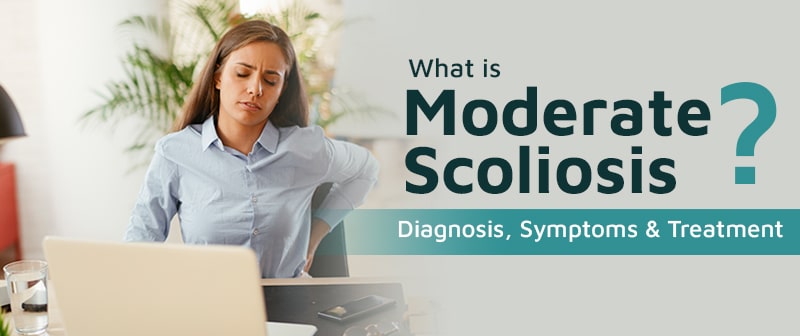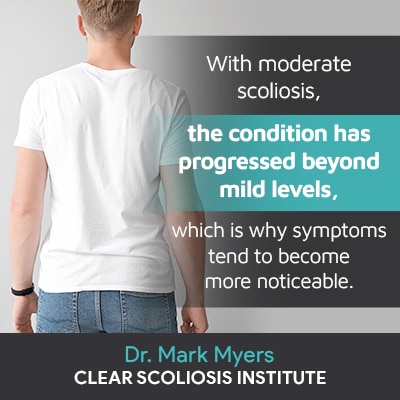
As a progressive condition, scoliosis has it in its nature to get worse over time, especially if left untreated, or not treated proactively. Scoliosis is not a static condition; if a patient is initially diagnosed with mild scoliosis, that doesn’t mean that’s where the condition will stay. As an abnormal spinal curvature gets larger, it can progress from mild to moderate and moderate to severe. Keep reading to find out how proactive treatment can work towards staying ahead of a condition’s progressive line.
There are different scoliosis severity levels that range from mild to moderate and severe. A measurement known as ‘Cobb angle’ indicates how far out of alignment a scoliotic spine has become. Patients with moderate scoliosis have a Cobb angle measurement of between 10 and 25 degrees.
Before moving on to the specifics of ‘moderate scoliosis’, let’s expand on how conditions are classified as mild, moderate, or severe.
As part of the diagnostic process, scoliosis is assessed and classified based on a number of important patient and condition characteristics.
In addition to patient age, condition type, and curvature location, condition severity is an important variable that tells me how far out of alignment a patient’s scoliosis has caused their spine to become.
In order for a scoliosis diagnosis to be given, certain parameters have to be met. A patient has to have an abnormal sideways spinal curvature, with rotation, and a minimum Cobb angle measurement of 10 degrees.
Cobb angle is known as the gold standard for diagnosing and assessing scoliosis. It is a measurement obtained during X-ray that involves drawing intersecting lines from the tops and bottoms of the curvature’s most-tilted vertebrae (bones of the spine); this will involve multiple vertebrae at the apex of the curve.
While every case is unique, generally speaking, the higher a patient’s Cobb angle, the more severe their condition is, and the more likely it is to cause noticeable symptoms such as postural changes and pain (more common in adults):
Mild scoliosis: Cobb angle measurement of between 10 and 25 degrees
Moderate scoliosis: Cobb angle measurement of between 25 and 40 degrees
Severe scoliosis: Cobb angle measurement of 40+ degrees
Again, the important thing to understand about scoliosis is that where a condition is at, in terms of severity, at the time of diagnosis, is not indicative of where it will stay, which is why proactive treatment is so important.
Before we move on to discussing what proactive treatment involves and can achieve, let’s first explore some of the common symptoms associated with moderate scoliosis.
While having an abnormal sideways curvature of the spine might seem like a condition that would be easy to spot, that is not always the case, especially in mild forms.
Mild scoliosis doesn’t commonly produce functional deficits, or overly-noticeable postural changes, at least not for the average person untrained in how to spot the condition’s early signs; however, it can easily progress from mild to moderate without parents, peers, or even pediatricians noticing.
This is why the majority of scoliosis patients are in the moderate stage when they are diagnosed as this is when the condition tends to start producing noticeable symptoms that lead to a diagnosis and treatment.
While there are different types of scoliosis that can develop, the most prevalent form is adolescent idiopathic scoliosis (AIS), diagnosed between the ages of 10 and 18. While scoliosis also affects adults, it’s more commonly diagnosed in children and adolescents, and for children and adolescents, the condition is not generally described as painful; adults experience scoliosis-related pain differently.
In children and adolescents who have not yet reached skeletal maturity, their bodies are still growing, including their spines, and growth means the spine is experiencing a lengthening motion that can counteract the compressive force of the abnormal spinal curve.
In adults who are no longer growing, their spines are vulnerable to the compression introduced by the unnatural curvature, and this can affect the spine and its surrounding muscles and nerves. When nerves are involved, this can cause radiating pain felt in the legs, feet, and other areas of the body.
So in the condition’s most prevalent form (AIS), early detection isn’t always easy to achieve because it’s not frequently painful, nor is it commonly associated with functional deficits or noticeable postural changes, at least not in the early stages of its progressive line.
While every case is different, when a condition progresses into the moderate stage of progression, it can start to produce more noticeable postural changes that impact the body’s overall symmetry. Some common symptoms of moderate scoliosis include:
It’s important to understand that as patients with moderate scoliosis have progressed past the mild stage, they are almost guaranteed to continue progressing, at varying rates.

It’s also fairly common for patients with moderate scoliosis to have issues with balance, coordination, and to experience changes in gait.
In addition, out of all the body’s nerves, only 6 percent sense pain; the remaining 94 percent control bodily functions, which is why, especially when left untreated, scoliosis has the potential to cause various organs to malfunction.
So if you, or someone you care about, has noticed some of the aforementioned symptoms and been diagnosed with moderate scoliosis, what’s the next step?
While there are never treatment guarantees, there are a number of treatment benefits associated with early detection, but these benefits are only available to those who choose to follow a treatment approach that values proactive treatment.
As different treatment approaches offer patients different potential outcomes, choosing the type of treatment to commit to can have far-reaching effects.
With moderate scoliosis, the condition has progressed beyond mild levels, which is why symptoms tend to become more noticeable.
Even though symptoms tend to be more obvious with moderate scoliosis, those following a traditional approach to scoliosis treatment would likely be told to mainly observe the condition moving forward.
Here at the CLEAR Scoliosis Institute, we offer a conservative chiropractic-centered treatment approach that values proactive treatment. Monitoring a moderate condition for progression, which we know is likely to happen at some point, without applying proactive treatment, is akin to allowing a curvature to progress unimpeded.

To me, while a condition is at its mildest is the best time to start treatment; being proactive with treatment can help spare patients the hardships associated with further progression and the need for more invasive forms of treatment down the road.
As a CLEAR-certified scoliosis chiropractor, I believe in proactive treatment that involves the integration of multiple treatment disciplines for a truly customized and effective treatment approach.
I combine scoliosis-specific chiropractic care, in-office therapy, custom-prescribed home exercises, and corrective bracing, and can apportion these disciplines accordingly based on how the spine is responding to treatment.
Together, I work closely with my patients to impact conditions on a structural level in the form of a curvature reduction, and increasing core strength can help ensure the spine is optimally supported and stabilized.
While cases of moderate scoliosis have progressed beyond the mild stage and tend to start producing more noticeable symptoms, the time to start treatment is always now, before a condition progresses further.
While moderate scoliosis patients have a curvature size of between 10 and 25 degrees, that doesn’t mean this is where their curve will stay; while everyone has their own progressive rate, at some point, that moderate curvature is likely to get larger, especially if left untreated, or not treated proactively.
Starting proactive treatment early on in the condition’s progressive line means crafting and implementing an effective treatment plan as close to the time of diagnosis as possible, in the best interest of controlling progression.
While no treatment results can ever be guaranteed, the treatment benefits associated with early detection include treating a smaller curvature while it is still small, while the spine is more flexible, and before the body has had ample time to adjust to the curvature’s presence.
After all, there is no harm in using proactive treatment to reduce a moderate curve to a mild one, but allowing a moderate curvature to progress into the severe stage unimpeded can lead to a very different outcome.
When a conservative chiropractic-centered approach that values proactive treatment, like the one we offer patients of the CLEAR Scoliosis Institute, is committed to and implemented, our results speak for themselves.
Clear-institute.org - Cobb Angle
Clear-institute.org - Certification Process
Clear-institute.org - The CLEAR Approach

CLEAR provides a unique and innovative way of understanding scoliosis. Sign up to receive facts and information you won’t find anywhere else.
